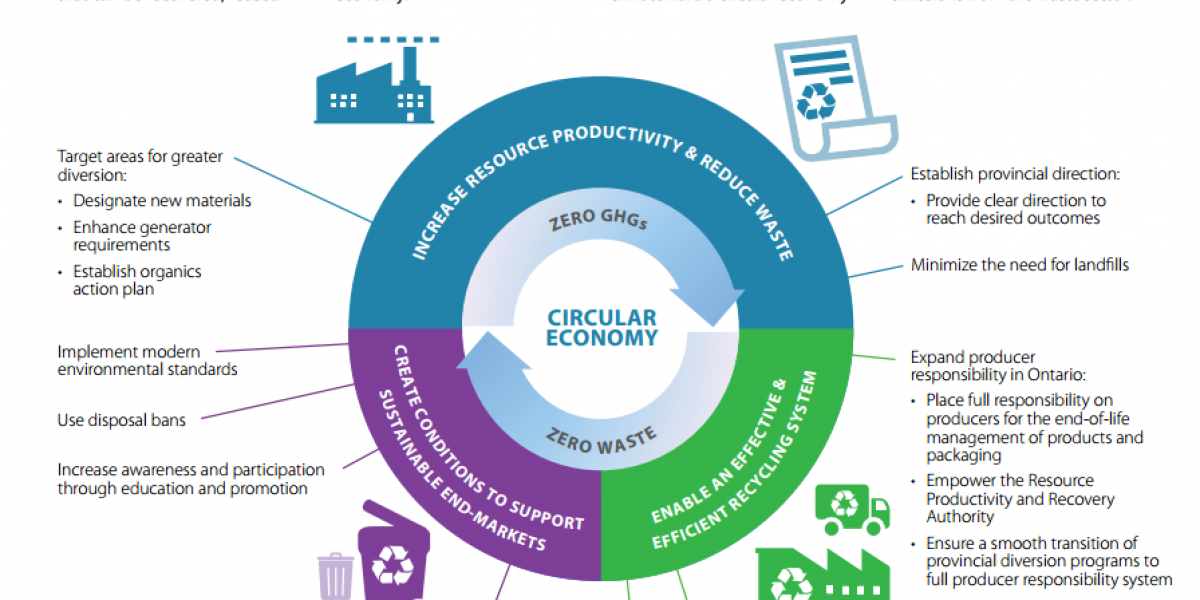
Image taken from the Draft Strategy for a Waste Free Ontario: Building the Circular Economy.
Recently, Ontario drafted new legislation to replace its Waste Diversion Act, 2002, with the Resource Recovery and Circular Economy Act and the Strategy for a Waste Free Ontario: Building the Circular Economy, both of which have been posted to the Ontario Environmental Registry for a 90-day review and comment period. The Strategy lays out an extremely ambitious vision for a zero waste or “circular” economy for Ontario, in which products are designed, packaged and handled so that they’re reused in the production process once they reach the end of their product life, instead of being sent to landfills.
Improvements to Ontario’s recycling and waste diversion policies were long overdue. On the policy side, the Government’s previous eco-fees programme was criticized for being confusing to some retailers and consumers and for not offering producers enough incentives to recover resources. Stats on waste diversion have been underwhelming as well - recycling rates in Ontario have been stuck at around 25% for the better part of a decade. Ontarians produced approximately 12 million tonnes of waste in 2013 – nearly the equivalent of one tonne per capita! Continuing with business-as-usual will stress landfill capacity and, in the case of organic wastes, have significant implications for Ontario’s climate change goals. (Decomposing organic materials from landfills lead to methane emissions, a greenhouse gas which is over twenty-five times more potent than CO2.) While the goal to get to a zero waste economy is ambitious, making big strides forward is definitely possible. Some Ontario municipalities already divert much larger shares of their waste from landfills than others (for example, Guelph diverted nearly 70% of its waste from landfills in 2013, whereas other municipalities diverted less than 20%), so improving “end-of-pipe” waste reduction outcomes in the province is definitely possible.
This naturally leads us to ask whether the new Act and Strategy are up to the challenges facing the province.
Some highlights of the Act include:
The Strategy for a Waste Free Ontario also outlines five key actions for kick-starting the circular economy:
The new Act and Strategy could also bring strong economic benefits in addition to minimising waste. The Ministry of Environment and Climate Change has estimated that every 1000 tonnes of waste diverted creates 60% greater Gross Domestic Product and 40% more jobs compared to disposal. The proposed amendments are also supported by a broad range of industry and environmental organizations, including the Canadian Beverage Association, Unilever Canada, the Recycling Council of Ontario, and Canadians for Clean Prosperity, many of which are praising the cost-effectiveness and credibility of the legislation. IPR measures have also been championed by Governments at multiple levels: the Canadian Council of Ministers of Environment has drafted national action plans on extended producer responsibility and sustainable packaging regimes, and 85 elected municipal candidates are supporting the expansion of IPR and circular economy measures in Ontario.
This is all exciting stuff, but much remains to be fleshed out, both in terms of the scope of the IPR regulations (how stringent are the recovery requirements going to be?) and the instruments used for meeting the targets (what tools can Government use to meet their overall waste diversion targets?). While the Strategy mentions that brand-holders will have flexibility in meeting their resource recovery targets, and that "Ontario would use a variety of tools and actions to encourage producers to show leadership and innovation in resource productivity to prevent waste", it doesn’t explicitly mention market-based instruments, such as tradeable quotas, pollution fees, or fiscal measures such as tax breaks. They only note that “the province would consult extensively on the proposed use of specific tools and actions”. Ontario would be wise to consider using market-based instruments, since appropriately designed MBIs can ensure flexibility and cost-effectiveness in resource recovery and waste reduction, and can also help all parts of society (households, retailers, distributors and producers) get in on the economic and environmental opportunities offered through waste reduction and resource recovery efforts.
Sustainable Prosperity has recently explored the municipal potential for broader use of market-based instruments in our Sustainability Alignment Manual, and provincial and municipal Governments would do well to consider using MBIs to meet their waste diversion goals. As a complement to IPR schemes, instruments on the “demand pull” side could include increasing per-unit waste collection fees (“pay as you throw”), as well as incineration and landfill fees, to incent firms and households to find alternatives to sending their waste to landfill. On the “supply push” side, this could include tax rebates to producers using recovered materials. That being said, interactions between “push” and “pull” instruments will need to be carefully considered in order to ensure that measures are cost-effective – eg. producers are not being subsidized to undertake activities which they would have done anyways.
The Act and Strategy are now in the public comment stage – meaning Ontarians have the opportunity now to say how they’d like to see the zero waste target realized. While this bold zero waste target is promising, the effectiveness of this new approach will in large part be determined by the details – stringency and policy/instrument design will be key factors in determining if the Strategy is sending the right economic signals to businesses and the public on the true costs of waste. But just think what’s possible if we get the signals right – a circular economy for Ontario, where we maximize the use of our resources, promote jobs and economic growth, and minimize our environmental footprint -- what’s not to like about that? Let’s just make sure we get the details right.